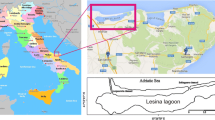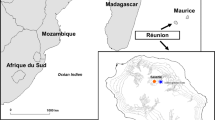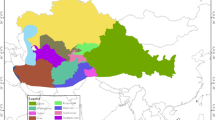Abstract
Foxtail millet, Setaria italica is still cultivated in Mazandaran (N-Iran). It is used for the preparation of local food and for feeding cage-birds. The cultivated race is convar. moharia, formerly widely grown from Europe to SW Asia. The newly found material allows conclusion with respect to evolution and distribution of this old crop.

Similar content being viewed by others
Notes
Setaria italica subsp. moharia (Alef.) Scholz in Willdenowia 36 (2006) 663
References
Alefeld F (1866) Landwirtschaftliche Flora oder die nutzbaren kultivierten Garten- und Feldgewächse Mitteleuropas. Berlin
Baik M.-C, Hoang H.-Dz, Hammer K (1986) A check-list of Korean cultivated plants. Kulturpflanze 34:69–144
Bor NL (1970) Gramineae. In: Rechinger KH (ed) Flora Iranica. 70:203–211. Graz, Austria: Akademische Druck- u. Verlagsanstalt
Clayton WD (1980) Setaria P. Beauv. In: Flora Europaea 5:263–264
Darmency H, Pernès J (1987) An inheritance study of domestication in foxtail millet using interspecific crosses. Plant Breed 99:30–33
Darmency H (2005) Incestuous relations of foxtail millet (Setaria italica) with its parents and cousins. In: Gressel J (ed) Crop ferality and volunteerism. CRC Press, Boca Raton, pp 81–96
Dekaprelevich LL, Kasparian AS (1928) A contribution to the study of foxtail millet (Setaria italica P.B. maxima Alef.) cultivated in Georgia (western Transcaucasia). Bull Appl Bot Plant Breed 19:533–572
De Wet JMJ, Oestry-Stidd LL, Cubero JI (1979) Origins and evolution of foxtail millets. J Agric Trop Bot Appl 26:54–64
Fritsch R (2001) Panicoideae. In: Hanelt P. and Institute of Plant Genetics and Crop Plant Research (eds) Mansfeld’s encyclopedia of agricultural and horticultural crops, vol 5. pp 2627–2750
Fukunaga K, Wang Z, Kato K, Kawase M (2002) Geographical variation of nuclear genome RFLPs and genetic differentiation in foxtail millet, Setaria italica (L.) P. Beauv. Genet Resour Crop Evol 49:95–101
Gao MJ, Chen JJ (1988) Isozymic studies on the origin of cultivated foxtail millet. Acta Agron Sinica 14:131–136 (in Chinese)
Hammer K, Knüpffer H, Laghetti G, Perrino P (1999) Seeds from the past. A catalogue of crop germplasm in the Central and North Italy. IdG, Bari
Hammer K, Heller J, Engels J (2001) Monographs on underutilized and neglected crops. Genet Resour Crop Evol 48:3–5
Harlan JR (1965) The possible role of weed races in the evolution of cultivated plants. Euphytica 14:173–176
Hoops J (1905) Waldbäume und Kulturpflanzen im germanischen Altertum. Straßburg
Jusuf M, Pernès J (1985) Genetic variability of foxtail millet (Setaria italica P. Beauv.). Theor Appl Genet 71:385–391
Kawase M, Sakamoto S (1984) Variation, geographical distribution and genetic analysis of esterase isozymes in foxtail millet, Setaria italica (L.) P. Beauv. Theor Appl Genet 67:529–533
Khoshbakht K (2005) Agrobiodiversity of plant genetic resources in Savadkouh/Iran with emphasis on plant uses and socioeconomic aspects. Ph.D. Thesis, Faculty of Organic Agricultural Sciences, University of Kassel, Witzenhausen, Germany
Körnicke F (1885) Die Arten und Varietäten des Getreides. Handbuch des Getreidebaus, Bd. 1
Kühn F, Hammer K (1979) Das Ausklingen der Brandrodungskultur in Zentraleuropa. Kulturpflanze 27:165–173
Li J, Wu SZ, Cao JS (1995) Cluster analysis of an international collection of foxtail millet (Setaria italica (L.) P. Beauv.). Euphytica 83:79–85
Li J, Wu SZ (1996) Traditional maintenance and multiplication of foxtail millet (Setaria italica (L.) P. Beauv.) in China. Euphytica 87:33–38
Li J, Wu SZ, Cao JS, Zhang X (1996) A phenotypic diversity analysis of foxtail millet (Setaria italica (L.) P. Beauv.) landraces of Chinese origin. Genet Resour Crop Evol 43:377–384
Li J, Jia J, Wang J, Wu SZ (1998) Intraspecific and interspecific variation in Setaria revealed by RAPD analysis. Genet Resour Crop Evol 45:279–285
Maissurian NA (1929) The millet of Georgia. Bull Appl Bot Plant Breed 22:147–184
Mansfeld R (1952) Zur Systematik und Nomenklatur der Hirsen. Züchter 22:304–315
Metzger J (1841) Landwirtschaftliche Pflanzenkunde. Heidelberg
Nguyen van E, Pernès J (1985) Genetic diversity of foxtail millet (Setaria italica). In: Jacquard P et al. (eds) Genetic differentiation and dispersal in plants, Springer, Berlin, Heidelberg, pp 113–128
Pernès J (1985) Evolution des plants cultivées: ľ example des céréals. La vie Sci 5:429–447
Prasada Rao KE, de Wet JMJ, Brink DE, Mengesha MH (1987) Intraspecific variation and systematics of cultivated Setaria italica, foxtail millet (Poaceae). Econ Bot 41:108–116
Sakamoto S (1987) Origin and dispersal of common millet and foxtail millet. JARQ 21:84–89
Scheibe A (1943) Die Hirsen im Hindukush. Eine Beitrag zur Kenntnis von Kulturpflanzen in geographischer Rückzugsposition. Z Pflanzenzüchtg 25:392–436
Scholz H (1981) Ergänzungen und Verbesserungen zur “Flora iranica”: Gramineae. Willdenowia 11:259–266
Takahashi N, Hoshino T (1934) Natural crossing in Setaria italica (Beauv.). Proc Crop Sci Soc Japan 6:3–19
Till-Bottrand I, Reboud X, Braband P, Lefranc M, Kherissi B, Vedel F, Darmency H (1992) Outcrossing and hybridization in wild and cultivated foxtail millets; consequences for the release of transgenic crops. Theor Appl Genet 83:940–946
Tzvelev NV (1976) Zlaki SSSR. (Poaceae URSS). Nauka, Leningrad
Vavilov NI (1926) Studies of the origin of cultivated plants. Inst Appl Bot Plant Breed Leningrad
Vavilov NI, Bukinich DD (1929) Agricultural Afghanistan (Russ., Engl. summary) Leningrad
Werth E (1937) Zur Geographie und Geschichte der Hirsen. (Zur Geographie und Geschichte der Kulturpflanzen und Haustiere. XIII). Angew Bot 19:42–88
Williams RD, Schreiber MM (1976) Numerical and chemotaxonomy of the green foxtail complex. Weed Sci 24:331–335
Zohary D, Hopf M (1988) Domestication of plants in the Old world. Oxford University Press, Oxford
Author information
Authors and Affiliations
Corresponding author
Rights and permissions
About this article
Cite this article
Hammer, K., Khoshbakht, K. Foxtail millet (Setaria italica (L.) P. Beauv.) in Mazandaran/Northern Iran. Genet Resour Crop Evol 54, 907–911 (2007). https://doi.org/10.1007/s10722-007-9211-z
Received:
Accepted:
Published:
Issue Date:
DOI: https://doi.org/10.1007/s10722-007-9211-z




